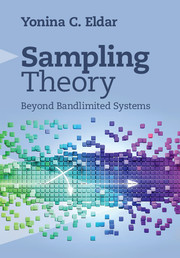Book contents
- Frontmatter
- Dedication
- Contents
- Preface
- 1 Introduction
- 2 Introduction to linear algebra
- 3 Fourier analysis
- 4 Signal spaces
- 5 Shift-invariant spaces
- 6 Subspace priors
- 7 Smoothness priors
- 8 Nonlinear sampling
- 9 Resampling
- 10 Union of subspaces
- 11 Compressed sensing
- 12 Sampling over finite unions
- 13 Sampling over shift-invariant unions
- 14 Multiband sampling
- 15 Finite rate of innovation sampling
- Appendix A Finite linear algebra
- Appendix B Stochastic signals
- References
- Index
14 - Multiband sampling
Published online by Cambridge University Press: 05 August 2014
- Frontmatter
- Dedication
- Contents
- Preface
- 1 Introduction
- 2 Introduction to linear algebra
- 3 Fourier analysis
- 4 Signal spaces
- 5 Shift-invariant spaces
- 6 Subspace priors
- 7 Smoothness priors
- 8 Nonlinear sampling
- 9 Resampling
- 10 Union of subspaces
- 11 Compressed sensing
- 12 Sampling over finite unions
- 13 Sampling over shift-invariant unions
- 14 Multiband sampling
- 15 Finite rate of innovation sampling
- Appendix A Finite linear algebra
- Appendix B Stochastic signals
- References
- Index
Summary
In this chapter we consider sampling of multiband signals, namely, signals whose Fourier transform comprises a small number of bands, spread over a possibly wide frequency range. We begin by discussing the case in which the carrier frequencies, or band positions, are known. We review both classical methods and techniques based on interleaved ADC structures to sample such signals at a rate proportional to the actual band occupancy, and not to the high Nyquist rate associated with the highest frequency. The more challenging scenario in which the carrier frequencies are unknown, resulting in a union of subspace model, is treated next. Combining sampling approaches for the case in which the carriers are known, with methods for compressed sampling of analog signals developed in the previous chapter, leads to several sub-Nyquist sampling techniques for multiband signals with unknown band positions. Along with developing the theoretical concepts, we address practical constraints and present an example of a sub-Nyquist hardware realization for this class of signals.
Sampling of multiband signals
Consider the scenario of a multiband input x(t), which has sparse spectra, such that its CTFT X(ω) is supported on N frequency intervals, or bands, with individual widths not exceeding B. In addition, the largest frequency component is below ωmax. Figure 14.1 illustrates a typical multiband spectrum. Multiband models are common in communication channels, when a receiver intercepts several RF transmissions, each modulated onto a different (possibly high) carrier frequency.
- Type
- Chapter
- Information
- Sampling TheoryBeyond Bandlimited Systems, pp. 569 - 641Publisher: Cambridge University PressPrint publication year: 2015

